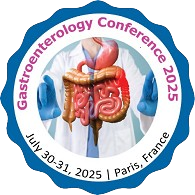Scientific Sessions/Tracks
Gastroenterology focuses on the diagnosis and treatment of disorders related to the digestive tract and liver. This field encompasses a wide range of conditions, from common ailments like gastroesophageal reflux disease (GERD) to more complex liver disorders such as cirrhosis and hepatitis. The liver, being a central organ in digestion and metabolism, plays a crucial role in maintaining overall health. Gastroenterologists often collaborate with hepatologists to provide comprehensive care for patients with liver diseases, aiming to manage symptoms, prevent complications, and improve quality of life.
Recent advancements in gastroenterology have led to improved diagnostic tools and treatment options. Techniques such as endoscopic ultrasound and novel imaging modalities have enhanced the ability to diagnose gastrointestinal and liver conditions with greater accuracy. Additionally, therapeutic innovations, including targeted therapies and minimally invasive procedures, have revolutionized the management of chronic liver diseases and gastrointestinal disorders.
The integration of multidisciplinary approaches in gastroenterology has proven beneficial in addressing complex cases. Collaborative care involving gastroenterologists, hepatologists, surgeons, and nutritionists ensures a holistic approach to patient management. This teamwork is essential in handling multifaceted conditions like liver fibrosis and inflammatory bowel disease, highlighting the importance of coordinated care in optimizing patient outcomes.
Innovations in gastrointestinal imaging are revolutionizing the diagnosis and management of gastrointestinal diseases. Advanced imaging techniques, such as high-resolution endoscopy, magnetic resonance imaging (MRI), and computed tomography (CT) scans, have significantly improved the visualization of the gastrointestinal tract. These technologies enable early detection of abnormalities, precise localization of lesions, and better assessment of disease severity, facilitating timely and accurate interventions.
The integration of artificial intelligence (AI) in gastrointestinal imaging is another breakthrough. AI algorithms can analyze imaging data with remarkable speed and accuracy, aiding in the identification of subtle changes that might be missed by human eyes. This technology enhances diagnostic precision and helps in predicting disease outcomes, thus optimizing treatment plans. Additionally, AI-driven imaging tools are being developed to assist in real-time decision-making during endoscopic procedures, further improving patient outcomes.
The future of gastrointestinal imaging is promising, with ongoing research focusing on enhancing image quality, reducing radiation exposure, and developing non-invasive imaging techniques. Innovations such as molecular imaging, which provides insights into the molecular and cellular aspects of diseases, are expected to transform the field. These advancements will not only improve diagnostic accuracy but also pave the way for personalized medicine, where treatments can be tailored to the individual characteristics of each patient's disease.
Understanding the molecular mechanisms underlying liver disease is crucial for developing targeted therapies. Liver diseases, such as hepatitis, cirrhosis, and hepatocellular carcinoma, involve complex interactions between genetic, epigenetic, and environmental factors. Research in this area focuses on elucidating the molecular pathways that drive liver inflammation, fibrosis, and cancer development, providing insights into potential therapeutic targets.
Recent studies have highlighted the role of specific genes, proteins, and signaling pathways in the progression of liver disease. For instance, the dysregulation of the Wnt/β-catenin pathway is implicated in hepatocellular carcinoma, while the TGF-β signaling pathway plays a pivotal role in liver fibrosis. Additionally, the gut-liver axis, involving the interaction between the gut microbiome and liver, is emerging as a significant factor in liver disease pathogenesis, offering new avenues for therapeutic intervention.
Advances in molecular biology techniques, such as next-generation sequencing and CRISPR-Cas9 gene editing, are accelerating the discovery of novel molecular targets and biomarkers for liver disease. These technologies enable researchers to explore the genetic and epigenetic alterations associated with liver disease, facilitating the development of precision medicine approaches. By targeting the underlying molecular mechanisms, future therapies can be more effective and personalized, improving outcomes for patients with liver disease.
Hepatocellular carcinoma (HCC) is the most common type of primary liver cancer, and its treatment has seen significant advancements in recent years. Traditional therapies, such as surgical resection and liver transplantation, remain the cornerstone of curative treatment for early-stage HCC. However, these options are not suitable for all patients, particularly those with advanced disease or underlying liver dysfunction.
The advent of targeted therapies and immunotherapies has revolutionized the management of advanced HCC. Targeted agents, such as sorafenib and lenvatinib, inhibit specific molecular pathways involved in tumor growth and angiogenesis, offering a survival benefit for patients with advanced HCC. Immunotherapies, including immune checkpoint inhibitors like nivolumab and pembrolizumab, have shown promising results by enhancing the body's immune response against cancer cells, providing new hope for patients with previously limited treatment options.
Research is ongoing to identify biomarkers that can predict response to these therapies and to develop combination treatments that can overcome resistance mechanisms. Additionally, innovative approaches, such as gene therapy and personalized medicine, are being explored to improve outcomes for HCC patients. These advances underscore the importance of a multidisciplinary approach in the management of HCC, integrating surgical, medical, and interventional strategies to optimize patient care.
Gastrointestinal oncology is witnessing several emerging trends that are transforming the landscape of cancer diagnosis and treatment. One significant trend is the increasing use of liquid biopsy, a non-invasive method that analyzes circulating tumor DNA (ctDNA) and other biomarkers in the blood. Liquid biopsies offer a less invasive alternative to traditional tissue biopsies, enabling early detection, monitoring of treatment response, and identification of resistance mechanisms in gastrointestinal cancers.
Personalized medicine is another pivotal trend in gastrointestinal oncology. Advances in genomic profiling and molecular diagnostics have enabled the identification of specific genetic alterations driving cancer growth. This knowledge allows for the development of targeted therapies tailored to the individual genetic makeup of a patient's tumor. For example, HER2-targeted therapies have shown efficacy in HER2-positive gastric cancer, while BRAF inhibitors are used in BRAF-mutant colorectal cancer, exemplifying the shift towards precision oncology.
Immunotherapy continues to gain prominence in the treatment of gastrointestinal cancers. Immune checkpoint inhibitors, such as pembrolizumab and nivolumab, have demonstrated efficacy in various gastrointestinal malignancies, including colorectal and gastric cancers. The combination of immunotherapy with other treatment modalities, such as chemotherapy and targeted therapy, is being actively explored to enhance therapeutic outcomes. These trends highlight the dynamic and rapidly evolving nature of gastrointestinal oncology, offering new avenues for improving patient survival and quality of life.
Personalized medicine is transforming the field of gastroenterology by tailoring treatments to the individual characteristics of each patient. This approach considers genetic, environmental, and lifestyle factors to optimize therapeutic strategies for gastrointestinal disorders. Advances in genomics and molecular biology have enabled the identification of specific biomarkers and genetic mutations associated with various gastrointestinal diseases, facilitating more precise diagnosis and treatment.
In the context of inflammatory bowel disease (IBD), personalized medicine is making significant strides. Genetic and molecular profiling of patients with IBD helps in predicting disease course, response to therapy, and risk of complications. This information guides the selection of biologic agents, immunomodulators, and other treatments, reducing trial and error in managing the disease. Personalized approaches also extend to dietary and lifestyle modifications, which can be tailored based on an individual's genetic predispositions and gut microbiome composition.
The future of personalized medicine in gastroenterology holds immense promise, with ongoing research focusing on integrating multi-omics data, including genomics, proteomics, and metabolomics, to gain a comprehensive understanding of gastrointestinal diseases. The development of advanced diagnostic tools, such as next-generation sequencing and liquid biopsies, further enhances the ability to personalize treatment. By leveraging these innovations, gastroenterologists can deliver more effective and individualized care, improving outcomes and quality of life for patients with gastrointestinal disorders.
The management of inflammatory bowel disease (IBD), encompassing Crohn's disease and ulcerative colitis, has evolved significantly with advances in medical therapy and personalized treatment approaches. The primary goals of IBD management are to induce and maintain remission, prevent complications, and improve quality of life for patients. A multidisciplinary approach, involving gastroenterologists, dietitians, and mental health professionals, is essential for comprehensive care.
Biologic therapies have revolutionized IBD treatment, targeting specific components of the immune system to reduce inflammation. Tumor necrosis factor (TNF) inhibitors, such as infliximab and adalimumab, have shown efficacy in inducing and maintaining remission in IBD patients. Newer biologics, like vedolizumab and ustekinumab, target different pathways and offer additional options for patients who do not respond to traditional treatments. Small molecule drugs, such as tofacitinib, are also emerging as effective therapies for IBD.
Personalized medicine is playing an increasingly important role in IBD management. Genetic and molecular profiling helps in predicting disease behavior and response to therapy, enabling tailored treatment plans. Monitoring biomarkers, such as fecal calprotectin and C-reactive protein (CRP), aids in assessing disease activity and guiding therapy adjustments. Additionally, incorporating dietary interventions and stress management strategies based on individual patient profiles contributes to holistic IBD management, enhancing overall patient outcomes.
Hepatitis B and C are major global health concerns, with significant advancements in their treatment over the past decade. For hepatitis B, antiviral therapies, such as entecavir and tenofovir, are the mainstay of treatment, effectively suppressing viral replication and reducing liver damage. However, these treatments often require long-term administration and do not cure the infection, necessitating ongoing research for more effective solutions.
The treatment landscape for hepatitis C has been transformed with the advent of direct-acting antivirals (DAAs). DAAs, such as sofosbuvir and ledipasvir, offer high cure rates with shorter treatment durations and fewer side effects compared to previous therapies. These medications target specific steps in the hepatitis C virus life cycle, leading to sustained virologic response and effectively curing the infection in most patients. The success of DAAs has significantly reduced the global burden of hepatitis C.
Future therapies for hepatitis B and C aim to achieve complete viral eradication and improve patient outcomes. Research is focused on developing novel antiviral agents, therapeutic vaccines, and immune-based therapies. For hepatitis B, combination therapies targeting different stages of the viral life cycle are being explored to enhance treatment efficacy. In hepatitis C, efforts are ongoing to develop pan-genotypic treatments that can cure all strains of the virus. These advancements hold the promise of eradicating hepatitis B and C as public health threats, improving the lives of millions affected by these chronic infections.
Gastrointestinal endoscopy has undergone remarkable advancements, enhancing its diagnostic and therapeutic capabilities. High-definition endoscopy and narrow-band imaging have improved the visualization of the mucosal surface, aiding in the early detection of lesions and subtle abnormalities. These technologies enhance the accuracy of diagnosing conditions such as Barrett's esophagus, colorectal polyps, and early-stage cancers, facilitating timely interventions.
Endoscopic ultrasound (EUS) is a significant advancement in gastrointestinal endoscopy, combining endoscopy and ultrasound to provide detailed images of the digestive tract and surrounding structures. EUS is invaluable in diagnosing and staging gastrointestinal cancers, assessing pancreatic and biliary disorders, and guiding fine-needle aspiration biopsies. This minimally invasive technique offers precise information, reducing the need for more invasive procedures and improving patient outcomes.
Therapeutic endoscopy has also seen significant progress, with techniques such as endoscopic mucosal resection (EMR) and endoscopic submucosal dissection (ESD) enabling the removal of early-stage tumors and precancerous lesions. These procedures are less invasive than traditional surgery, resulting in shorter recovery times and reduced complications. Additionally, advancements in hemostatic devices and techniques have improved the management of gastrointestinal bleeding, ensuring prompt and effective treatment. The continuous evolution of gastrointestinal endoscopy is expanding its applications and enhancing its role in patient care.
Nutritional management plays a crucial role in the care of patients with liver disease, influencing disease progression and overall health. Malnutrition is common in liver disease, particularly in advanced stages, and can significantly impact patient outcomes. A comprehensive nutritional assessment and tailored interventions are essential to address the specific needs of each patient, optimizing their nutritional status and supporting liver function.
For patients with cirrhosis, protein-energy malnutrition is a significant concern. Adequate protein intake is crucial to prevent muscle wasting, but dietary adjustments may be needed to manage complications such as hepatic encephalopathy. Small, frequent meals with balanced macronutrients are recommended to support metabolic demands and prevent malnutrition. In cases of hepatic encephalopathy, the use of branched-chain amino acids (BCAAs) may be beneficial, as they are less likely to exacerbate symptoms.
Micronutrient deficiencies, including vitamins A, D, E, K, and zinc, are common in liver disease and should be monitored and addressed. Supplementation may be necessary to correct these deficiencies and support overall health. Additionally, managing sodium intake is important in patients with ascites to prevent fluid retention. A multidisciplinary approach involving dietitians, hepatologists, and other healthcare professionals is essential to develop and implement personalized nutritional plans, improving the quality of life and outcomes for patients with liver disease.
The gut microbiome, comprising trillions of microorganisms residing in the gastrointestinal tract, plays a vital role in maintaining overall health and influencing the pathogenesis of various diseases. Advances in microbiome research have highlighted its significance in gastrointestinal health, immune function, and metabolic processes. Dysbiosis, an imbalance in the gut microbiome, is associated with several gastrointestinal disorders, including inflammatory bowel disease (IBD), irritable bowel syndrome (IBS), and colorectal cancer.
Restoring and maintaining a healthy gut microbiome is a key therapeutic strategy. Probiotics, prebiotics, and dietary modifications can promote a balanced microbiome, enhancing gut health and mitigating disease symptoms. For instance, specific probiotic strains have shown efficacy in managing IBD and IBS by modulating immune responses and improving gut barrier function. Dietary fibers and prebiotics, such as inulin and fructooligosaccharides, serve as substrates for beneficial gut bacteria, promoting their growth and activity.
Fecal microbiota transplantation (FMT) is an emerging therapeutic approach for treating recurrent Clostridioides difficile infection and is being explored for other gastrointestinal and metabolic disorders. FMT involves transferring stool from a healthy donor to the gastrointestinal tract of a patient, aiming to restore a healthy microbiome. Ongoing research is focused on understanding the complex interactions between the microbiome and host, identifying specific microbial signatures associated with health and disease, and developing targeted microbiome-based therapies to improve patient outcomes.
Pediatric gastroenterology addresses unique challenges in diagnosing and managing gastrointestinal disorders in children. Conditions such as inflammatory bowel disease (IBD), celiac disease, and functional gastrointestinal disorders require specialized approaches tailored to the pediatric population. Early diagnosis and intervention are crucial to prevent complications and ensure optimal growth and development.
Innovations in pediatric gastroenterology are enhancing diagnostic accuracy and treatment outcomes. Non-invasive diagnostic tools, such as fecal calprotectin and breath tests, are being increasingly utilized to assess gastrointestinal inflammation and detect conditions like lactose intolerance and small intestinal bacterial overgrowth. Advanced imaging techniques, including magnetic resonance enterography (MRE), provide detailed visualization of the gastrointestinal tract without radiation exposure, making them suitable for pediatric patients.
Therapeutic advances, such as biologic therapies, are improving the management of pediatric IBD, offering new treatment options for children who do not respond to conventional therapies. Personalized medicine approaches, considering genetic, environmental, and lifestyle factors, are being integrated into pediatric care to tailor treatments to the individual needs of each child. Additionally, dietary interventions, including exclusive enteral nutrition (EEN) and specific carbohydrate diets, are gaining recognition for their efficacy in managing pediatric gastrointestinal disorders, highlighting the importance of a comprehensive and multidisciplinary approach in pediatric gastroenterology.
Autoimmune liver diseases, including autoimmune hepatitis (AIH), primary biliary cholangitis (PBC), and primary sclerosing cholangitis (PSC), are chronic conditions characterized by immune-mediated liver damage. Early diagnosis and prompt treatment are essential to prevent disease progression and liver failure. These conditions often require a multidisciplinary approach involving hepatologists, immunologists, and other specialists to optimize patient care.
Autoimmune hepatitis (AIH) is managed with immunosuppressive therapies, such as corticosteroids and azathioprine, to reduce liver inflammation and achieve remission. Regular monitoring and adjustments in therapy are necessary to maintain disease control and minimize side effects. In refractory cases, second-line agents, such as mycophenolate mofetil and calcineurin inhibitors, may be considered. For primary biliary cholangitis (PBC), ursodeoxycholic acid (UDCA) is the mainstay of treatment, improving liver function and delaying disease progression. Obeticholic acid, a farnesoid X receptor agonist, is used in patients who do not respond adequately to UDCA.
Primary sclerosing cholangitis (PSC) poses significant therapeutic challenges due to the lack of effective medical treatments. Management focuses on symptom relief, prevention of complications, and monitoring for disease progression and malignancies. Liver transplantation remains the definitive treatment for patients with end-stage autoimmune liver disease or those with complications such as cholangiocarcinoma. Ongoing research aims to identify novel therapeutic targets and biomarkers to improve the management and outcomes of autoimmune liver diseases.
Liver transplantation is a life-saving procedure for patients with end-stage liver disease and acute liver failure. Advances in surgical techniques, perioperative care, and immunosuppressive therapy have significantly improved the success rates and outcomes of liver transplantation. However, challenges such as organ shortage and post-transplant complications continue to drive research and innovation in the field.
Current practices in liver transplantation emphasize careful recipient selection, optimizing perioperative care, and personalized immunosuppressive regimens to prevent rejection and minimize side effects. Living donor liver transplantation (LDLT) has emerged as a valuable option to expand the donor pool and reduce waiting times. Advances in surgical techniques, including laparoscopic and robotic-assisted procedures, are enhancing the safety and efficacy of LDLT, benefiting both donors and recipients.
Future directions in liver transplantation focus on addressing the organ shortage through innovative approaches such as ex vivo organ perfusion and bioengineering of liver grafts. Ex vivo perfusion techniques aim to preserve and assess the quality of donor organs before transplantation, potentially increasing the availability of suitable grafts. Research in regenerative medicine and tissue engineering holds promise for developing bioartificial liver constructs and enhancing liver regeneration, offering new possibilities for patients with liver failure. Additionally, advancements in immunomodulation and tolerance induction strategies aim to improve long-term graft survival and reduce the need for lifelong immunosuppression, further advancing the field of liver transplantation.
Esophageal disorders, including gastroesophageal reflux disease (GERD), Barrett's esophagus, and esophageal motility disorders, present significant diagnostic and therapeutic challenges. Accurate diagnosis is crucial for effective management and preventing complications. Advanced diagnostic techniques, such as high-resolution manometry (HRM) and pH monitoring, have improved the evaluation of esophageal motility and acid exposure, aiding in the diagnosis of conditions like achalasia and GERD.
Management of GERD involves lifestyle modifications, pharmacologic therapy, and, in refractory cases, surgical interventions. Proton pump inhibitors (PPIs) are the mainstay of pharmacologic treatment, reducing acid secretion and alleviating symptoms. Surgical options, such as laparoscopic fundoplication, are considered for patients with persistent symptoms despite medical therapy or those with complications like Barrett's esophagus. Endoscopic therapies, including radiofrequency ablation and endoscopic mucosal resection, are effective for treating Barrett's esophagus and preventing progression to esophageal adenocarcinoma.
Esophageal motility disorders, such as achalasia, are managed with a combination of medical, endoscopic, and surgical approaches. Endoscopic treatments, including pneumatic dilation and peroral endoscopic myotomy (POEM), have revolutionized the management of achalasia, offering effective and minimally invasive options. Botulinum toxin injections are another therapeutic option for certain motility disorders. The continuous evolution of diagnostic and therapeutic techniques is enhancing the management of esophageal disorders, improving patient outcomes and quality of life.
Gastrointestinal bleeding is a critical condition that requires prompt diagnosis and effective management to prevent severe outcomes. The bleeding can originate from various sources within the gastrointestinal tract, including the esophagus, stomach, small intestine, and colon. Identifying the precise location and cause of the bleeding is crucial for appropriate treatment. Diagnostic techniques such as endoscopy, angiography, and capsule endoscopy play a pivotal role in locating the source and assessing the severity of the bleed.
Management of gastrointestinal bleeding involves a combination of supportive care and targeted interventions. Initial treatment focuses on stabilizing the patient, including fluid resuscitation and blood transfusion if necessary. Once the bleeding source is identified, endoscopic procedures or surgical interventions may be required to control the hemorrhage. In addition to these acute measures, long-term management strategies include addressing underlying conditions, such as peptic ulcer disease or variceal bleeding, to prevent recurrence.
Recent advancements in technology and therapeutic approaches have improved outcomes for patients with gastrointestinal bleeding. Innovations such as endoscopic hemostatic techniques and the development of novel pharmacological agents have enhanced the ability to manage bleeding episodes more effectively. Ongoing research continues to explore new methods for prevention and treatment, aiming to reduce the incidence of gastrointestinal bleeding and improve patient care.
Hepatic encephalopathy (HE) is a complex neuropsychiatric condition resulting from liver dysfunction, often seen in patients with cirrhosis or acute liver failure. The pathogenesis of HE involves the accumulation of toxins, such as ammonia, due to impaired liver function. These toxins affect brain function, leading to symptoms ranging from mild cognitive changes to severe confusion and coma. Understanding the underlying mechanisms of HE is essential for developing effective treatment strategies.
Treatment of hepatic encephalopathy focuses on addressing the underlying liver disease and managing symptoms. Lactulose and rifaximin are commonly used to reduce ammonia levels in the blood, while supportive care involves managing electrolyte imbalances and addressing potential triggers such as infections or gastrointestinal bleeding. In severe cases, liver transplantation may be considered as a definitive treatment option for patients with advanced liver disease.
Recent research has provided new insights into the pathophysiology of HE, including the role of gut microbiota and neuroinflammation. Emerging therapies targeting these areas are being explored, offering hope for more effective management of the condition. Ongoing studies aim to refine treatment protocols and improve outcomes for patients suffering from hepatic encephalopathy, highlighting the importance of continued research in this field.
Colorectal cancer (CRC) is a leading cause of cancer-related morbidity and mortality worldwide. Screening and prevention are critical in reducing the incidence and improving outcomes for patients. Various screening methods, including colonoscopy, fecal occult blood tests, and flexible sigmoidoscopy, are used to detect CRC at an early stage when treatment is most effective. Guidelines recommend regular screening starting at age 45 or earlier for individuals with a family history or other risk factors.
Prevention strategies for colorectal cancer include lifestyle modifications and chemoprevention. Dietary changes, regular physical activity, and maintaining a healthy weight can significantly reduce the risk of CRC. Additionally, certain medications and supplements, such as aspirin and calcium, have shown potential in lowering CRC risk. For individuals with hereditary conditions like familial adenomatous polyposis or Lynch syndrome, more intensive surveillance and preventive measures may be necessary.
Advances in screening technology and risk assessment tools have improved the ability to detect colorectal cancer early and personalize prevention strategies. Novel biomarkers and genetic tests are being developed to enhance screening accuracy and identify individuals at higher risk. As research continues to evolve, the focus remains on implementing effective screening programs and preventive measures to reduce the burden of colorectal cancer.
Gastrointestinal motility disorders encompass a range of conditions characterized by abnormal movement of the digestive tract. These disorders can affect the esophagus, stomach, small intestine, and colon, leading to symptoms such as pain, bloating, and altered bowel habits. Conditions like irritable bowel syndrome (IBS), gastroparesis, and chronic constipation are examples of motility disorders that can significantly impact quality of life.
Diagnosis of gastrointestinal motility disorders involves a combination of clinical evaluation and specialized tests. Techniques such as manometry, scintigraphy, and motility studies help assess the function and coordination of the gastrointestinal tract. Accurate diagnosis is essential for tailoring treatment approaches to individual patients, as management strategies can vary widely depending on the specific disorder and its severity.
Treatment of gastrointestinal motility disorders often requires a multifaceted approach, including lifestyle modifications, pharmacological therapies, and sometimes surgical interventions. Medications that target motility, such as prokinetics or antispasmodics, can help alleviate symptoms. Additionally, dietary adjustments and stress management strategies may play a role in improving patient outcomes. Ongoing research into the pathophysiology of these disorders continues to inform new treatment options and enhance patient care.
Drug-induced liver injury (DILI) is a significant concern in both clinical practice and drug development, characterized by liver damage resulting from the use of medications. DILI can present with a range of symptoms, from mild liver enzyme elevations to severe liver failure. Identifying and managing DILI requires careful assessment of the patient's medication history, liver function tests, and exclusion of other potential causes of liver damage.
Management of DILI involves discontinuing the offending drug and providing supportive care to the patient. In cases of severe liver injury, additional interventions such as corticosteroids or N-acetylcysteine may be considered. It is essential for healthcare providers to recognize early signs of DILI and promptly address them to prevent progression to more severe liver damage.
Research into DILI continues to advance our understanding of the mechanisms underlying drug-induced liver damage and identify risk factors associated with its development. Pharmacogenomic studies are exploring genetic predispositions to DILI, aiming to personalize drug prescribing and minimize the risk of liver injury. As new drugs are developed, ongoing monitoring and reporting of DILI cases are crucial for ensuring patient safety and refining treatment guidelines.
Endoscopic ultrasound (EUS) is a valuable imaging technique in gastroenterology that combines endoscopy and ultrasound technology to provide detailed views of the gastrointestinal tract and surrounding structures. EUS is particularly useful for assessing conditions involving the esophagus, stomach, pancreas, and rectum, offering superior resolution compared to traditional imaging methods.
The application of EUS extends to both diagnostic and therapeutic purposes. It is instrumental in staging cancers, evaluating pancreaticobiliary disorders, and guiding fine-needle aspiration for tissue sampling. Additionally, EUS can assist in managing conditions such as cystic lesions or pancreaticobiliary obstructions by providing real-time imaging and allowing for targeted interventions.
Recent advancements in EUS technology, such as contrast-enhanced ultrasound and elastography, have further enhanced its diagnostic capabilities. These innovations improve the detection and characterization of lesions, allowing for more precise treatment planning. As EUS continues to evolve, it remains an essential tool in the comprehensive management of various gastrointestinal conditions, contributing to better patient outcomes.
Diabetes mellitus can lead to a range of gastroenterological complications, impacting the digestive system and overall quality of life. Common complications include gastroparesis, characterized by delayed gastric emptying, and diabetic diarrhea or constipation. These conditions arise from the effects of chronic hyperglycemia on gastrointestinal motility and nerve function.
Management of gastroenterological complications in diabetes involves controlling blood glucose levels and addressing specific gastrointestinal symptoms. Medications such as prokinetics or antidiarrheals may be prescribed to alleviate symptoms. Additionally, dietary modifications and lifestyle changes can play a significant role in managing these complications and improving patient comfort.
Research into the interplay between diabetes and gastrointestinal function continues to uncover new insights into pathophysiology and treatment. Advances in understanding the impact of glycemic control on gastrointestinal health are informing strategies to prevent and manage complications more effectively. Integrating these findings into clinical practice is crucial for providing comprehensive care to patients with diabetes and associated gastrointestinal issues.
Liver fibrosis is a progressive condition characterized by the accumulation of scar tissue in the liver, often resulting from chronic liver injury. It is a key feature of various liver diseases, including hepatitis C, non-alcoholic fatty liver disease (NAFLD), and alcoholic liver disease. Early detection and accurate assessment of liver fibrosis are essential for managing and potentially reversing the progression of liver disease.
Assessment of liver fibrosis typically involves a combination of clinical evaluation, imaging studies, and liver biopsy. Non-invasive methods, such as elastography and serum biomarkers, have become increasingly important for evaluating fibrosis without the need for invasive procedures. These tools help clinicians monitor disease progression and tailor treatment strategies to individual patients.
Management of liver fibrosis focuses on addressing the underlying cause of liver damage and implementing strategies to halt or reverse fibrosis. Treatment may involve antiviral therapy for viral hepatitis, lifestyle modifications for NAFLD, or abstinence from alcohol. Ongoing research into antifibrotic agents and novel therapeutic approaches aims to improve outcomes for patients with liver fibrosis and prevent progression to cirrhosis.
Gastrointestinal disorders during pregnancy are common and can significantly impact maternal and fetal health. Conditions such as nausea and vomiting of pregnancy, gastroesophageal reflux disease (GERD), and constipation are frequently experienced by pregnant women. These disorders often require careful management to alleviate symptoms and ensure a healthy pregnancy outcome.
Management of gastrointestinal disorders in pregnancy involves a combination of dietary modifications, lifestyle changes, and pharmacological treatments when necessary. For example, dietary adjustments and medications such as antacids or prokinetics may help manage GERD, while increased fluid intake and fiber can alleviate constipation. It is essential to consider the safety of treatments for both the mother and the developing fetus.
Research into gastrointestinal disorders during pregnancy continues to explore the impact of these conditions on maternal and fetal health and the effectiveness of various management strategies. Advances in understanding the interplay between pregnancy hormones and gastrointestinal function are informing new approaches to treatment. Ensuring optimal care for pregnant women with gastrointestinal disorders remains a priority in maternal health.
Biliary tract disorders involve conditions affecting the bile ducts, gallbladder, and bile flow. Common disorders include cholelithiasis (gallstones), cholangitis (bile duct infection), and primary biliary cholangitis (PBC). These conditions can lead to symptoms such as abdominal pain, jaundice, and itching, and may result in significant complications if left untreated.
Diagnosis of biliary tract disorders often involves imaging studies such as ultrasound, magnetic resonance cholangiopancreatography (MRCP), or endoscopic retrograde cholangiopancreatography (ERCP). These techniques help visualize the biliary system, identify obstructions or abnormalities, and guide treatment decisions. In some cases, endoscopic or surgical interventions may be required to address blockages or remove gallstones.
Management of biliary tract disorders focuses on relieving symptoms and addressing the underlying cause of the condition. Treatment options may include medication to dissolve gallstones, antibiotics for infections, or surgical procedures to remove the gallbladder or correct bile duct obstructions. Ongoing research aims to improve diagnostic methods and develop new therapies for biliary tract disorders, enhancing patient care and outcomes.
Innovations in gastrointestinal surgery have revolutionized the field, offering new techniques and technologies to improve patient outcomes. Advances such as minimally invasive laparoscopic surgery have reduced recovery times, postoperative pain, and hospital stays compared to traditional open surgery. These techniques allow for precise operations with smaller incisions, resulting in faster recovery and fewer complications.
Robotic-assisted surgery is another significant advancement, providing enhanced dexterity, precision, and visualization during procedures. Robotic systems allow surgeons to perform complex gastrointestinal surgeries with greater accuracy and control, potentially improving surgical outcomes and reducing the risk of complications. The integration of advanced imaging and navigation technologies further supports the precision and safety of these procedures.
Research and development in gastrointestinal surgery continue to focus on refining techniques, improving patient safety, and expanding the range of conditions that can be treated. Innovations such as natural orifice transluminal endoscopic surgery (NOTES) and advances in surgical instrumentation are being explored to further enhance surgical care. As technology continues to evolve, gastrointestinal surgery will likely see continued improvements in effectiveness and patient satisfaction.
Drug development in gastroenterology faces several challenges, including the complexity of gastrointestinal diseases and the need for targeted therapies. Conditions such as inflammatory bowel disease (IBD) and irritable bowel syndrome (IBS) have multifactorial etiologies, making it difficult to develop effective treatments that address all aspects of the disease. Additionally, variability in patient responses to treatment complicates the development of universal therapies.
Regulatory and clinical trial challenges also impact gastroenterology drug development. Designing trials that accurately assess efficacy and safety while accounting for diverse patient populations requires careful consideration. Moreover, obtaining regulatory approval for new drugs involves demonstrating clear clinical benefit and safety, which can be a lengthy and resource-intensive process.
Despite these challenges, recent advancements in personalized medicine and novel drug targets offer hope for improved treatments. Research into the molecular mechanisms underlying gastrointestinal diseases is paving the way for targeted therapies that address specific disease pathways. Ongoing efforts to streamline drug development processes and enhance clinical trial design aim to accelerate the availability of effective therapies for patients with gastrointestinal disorders.
Systemic diseases can have significant gastrointestinal manifestations, affecting the digestive tract and overall health. Conditions such as systemic lupus erythematosus, rheumatoid arthritis, and thyroid disorders can lead to gastrointestinal symptoms, including abdominal pain, nausea, and changes in bowel habits. Understanding the relationship between systemic diseases and gastrointestinal symptoms is crucial for providing comprehensive patient care.
Diagnosis of gastrointestinal symptoms in the context of systemic diseases requires a thorough evaluation to distinguish between primary gastrointestinal conditions and those related to the systemic illness. Diagnostic approaches may include imaging studies, endoscopy, and laboratory tests to assess both gastrointestinal and systemic aspects. Managing these symptoms often involves addressing the underlying systemic disease and providing symptomatic relief.
Treatment strategies for gastrointestinal symptoms in systemic diseases typically involve a multidisciplinary approach, including collaboration between rheumatologists, gastroenterologists, and other specialists. Effective management may require a combination of medications, lifestyle modifications, and supportive care tailored to the individual patient's needs. Ongoing research continues to explore the interactions between systemic diseases and gastrointestinal function, aiming to improve patient outcomes and quality of life.
Artificial intelligence (AI) is increasingly being integrated into gastroenterology to enhance diagnostic accuracy, treatment planning, and patient management. AI technologies, such as machine learning algorithms and deep learning models, are being applied to analyze medical imaging, interpret endoscopic findings, and predict disease outcomes. These advancements hold the potential to improve early detection and personalized treatment strategies in gastroenterology.
AI applications in gastroenterology include automated analysis of endoscopic images to identify abnormalities such as polyps or tumors. These tools can assist gastroenterologists in making more accurate diagnoses and reduce the risk of missed lesions. Additionally, predictive models using AI can help in assessing patient risk factors and guiding treatment decisions, leading to more targeted and effective care.
The integration of AI into gastroenterology also raises important considerations regarding data privacy, algorithm transparency, and the need for clinician oversight. Ongoing research and development aim to address these challenges while maximizing the benefits of AI in improving patient outcomes. As AI technology continues to evolve, its role in gastroenterology is expected to expand, offering new opportunities for advancing the field.
Patient-centered care in gastroenterology emphasizes the importance of considering patients' preferences, values, and needs in the management of their gastrointestinal conditions. This approach involves engaging patients in decision-making, providing clear communication, and ensuring that care plans align with their individual goals and concerns. By prioritizing the patient's perspective, healthcare providers can enhance the overall quality of care and patient satisfaction.
Implementing patient-centered care requires effective communication skills and a collaborative approach between patients and healthcare teams. This involves discussing treatment options, potential risks and benefits, and addressing any questions or concerns patients may have. Additionally, incorporating patient feedback and preferences into care plans ensures that treatments are tailored to individual needs and improve adherence.
Ongoing efforts to promote patient-centered care in gastroenterology include developing tools and resources to facilitate shared decision-making and enhancing patient education. Research into the impact of patient-centered approaches on outcomes and satisfaction continues to highlight the benefits of this model. As the field evolves, maintaining a focus on patient-centered care remains essential for optimizing treatment and achieving the best possible outcomes for patients with gastrointestinal disorders.






















